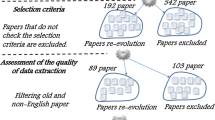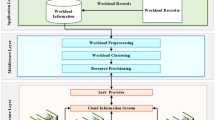Abstract
An adaptive workload balancing scheme is analyzed. This scheme is intended to automatically dissolve the imbalance in resource utilization of computing systems and to bring about the proper balance between throughput and turnaround time. This is done by means of the “invisible hand” due to the bidding of priorities of resource use, with no contradiction between the flexible bid for each resource and the stable price for the entire service. The result of this analysis shows that this scheme would regulate those imbalances, and that it includes the load balancing policy of IBM OS/VS2-2 as a special case. Some considerations and methods on an actual implementation are also presented.
Similar content being viewed by others
References
W. F. Sharpe,The Economics of Computers (Columbia Univ. Press, 1969).
M. Marchand, “Priority pricing with application to time-shared computers,” inProc. 1968 FJCC, pp. 493–498.
N. Singer, H. Kantor, and A. Moore, “Prices and the allocation of computer time,” inProc. 1968 FJCC, pp. 499–504.
L. Kleinrock, “Optimal bribing for queue position,”Operations Res. 15(12):304–318 (March–April 1967).
S. Smidt, “Flexible pricing of computer services,”Management Sci. 14(10):B581-B599 (June 1968).
N. Nielson, “Flexible pricing: an approach to the allocation of computer resources,” inProc. 1968 FJCC, pp. 521–531.
N. Nielson, “The allocation of computer resources-is pricing the answer?,”Comm. ACM 13(8):467–474 (August 1970).
Cunning, Inc., “The effects of charge-back policies,”EDP Analyzer 11(11):1–14 (November 1973).
S. Smidt, “The use of hard and soft money budgets and prices,” inProc. 1968 FJCC, pp. 511–519.
R. Mahl, “An analytical approach to computer systems scheduling,” RADC-TR-73-107, Univ. of Utah (June 1970).
IBM “OS/VS2 Planning Guide for Release 2” GC28-0667-1, 2nd ed. (November 1973).
Author information
Authors and Affiliations
Additional information
This paper is a revised version of material which appeared as Research Report RC5072 of IBM Thomas J. Watson Research Center, Yorktown Heights, New York.
On leave from the University of Electro-Communications, Chofu, Tokyo, Japan.
Rights and permissions
About this article
Cite this article
Kameda, H. The analysis of an adaptive workload balancing strategy in computing system resources management. International Journal of Computer and Information Sciences 4, 295–306 (1975). https://doi.org/10.1007/BF00979371
Received:
Revised:
Issue Date:
DOI: https://doi.org/10.1007/BF00979371




